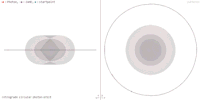
A photon sphere or photon circle arises in a neighbourhood of the event horizon of a black hole where gravity is so strong that emitted photons will not just bend around the black hole but also return to the point where they were emitted from and consequently display boomerang-like properties. As the source emitting photons falls into the gravitational field towards the event horizon the shape of the trajectory of each boomerang photon changes, tending to a more circular form. At a critical value of the radial distance from the singularity the trajectory of a boomerang photon will take the form of a non-stable circular orbit, thus forming a photon circle and hence in aggregation a photon sphere. The circular photon orbit is said to be the last photon orbit. The radius of the photon sphere, which is also the lower bound for any stable orbit, is, for a Schwarzschild black hole,
where G is the gravitational constant, M is the mass of the black hole, c is the speed of light in vacuum, and rs is the Schwarzschild radius (the radius of the event horizon); see below for a derivation of this result.
This equation entails that photon spheres can only exist in the space surrounding an extremely compact object (a black hole or possibly an "ultracompact" neutron star).
The photon sphere is located farther from the center of a black hole than the event horizon. Within a photon sphere, it is possible to imagine a photon that is emitted (or reflected) from the back of one's head and, following an orbit of the black hole, is then intercepted by the person's eye, allowing one to see the back of the head, see e.g. For non-rotating black holes, the photon sphere is a sphere of radius 3/2 rs. There are no stable free-fall orbits that exist within or cross the photon sphere. Any free-fall orbit that crosses it from the outside spirals into the black hole. Any orbit that crosses it from the inside escapes to infinity or falls back in and spirals into the black hole. No unaccelerated orbit with a semi-major axis less than this distance is possible, but within the photon sphere, a constant acceleration will allow a spacecraft or probe to hover above the event horizon.
Another property of the photon sphere is centrifugal force (note: not centripetal) reversal. Outside the photon sphere, the faster one orbits, the greater the outward force one feels. Centrifugal force falls to zero at the photon sphere, including non-freefall orbits at any speed, i.e. an object weighs the same no matter how fast it orbits, and becomes negative inside it. Inside the photon sphere, faster orbiting leads to greater weight or inward force. This has serious ramifications for the fluid dynamics of inward fluid flow.
A rotating black hole has two photon spheres. As a black hole rotates, it drags space with it. The photon sphere that is closer to the black hole is moving in the same direction as the rotation, whereas the photon sphere further away is moving against it. The greater the angular velocity of the rotation of a black hole, the greater the distance between the two photon spheres. Since the black hole has an axis of rotation, this only holds true if approaching the black hole in the direction of the equator. In a polar orbit, there is only one photon sphere. This is because when approaching at this angle, the possibility of traveling with or against the rotation does not exist. The rotation will instead cause the orbit to precess.
Derivation for a Schwarzschild black hole
Since a Schwarzschild black hole has spherical symmetry, all possible axes for a circular photon orbit are equivalent, and all circular orbits have the same radius.
This derivation involves using the Schwarzschild metric, given by
For a photon traveling at a constant radius r (i.e. in the φ-coordinate direction), . Since it is a photon, (a "light-like interval"). We can always rotate the coordinate system such that is constant, (e.g., ).
Setting ds, dr and dθ to zero, we have
Re-arranging gives
To proceed, we need the relation . To find it, we use the radial geodesic equation
Non vanishing -connection coefficients are
where .
We treat photon radial geodesics with constant r and , therefore
Substituting it all into the radial geodesic equation (the geodesic equation with the radial coordinate as the dependent variable), we obtain
Comparing it with what was obtained previously, we have
where we have inserted radians (imagine that the central mass, about which the photon is orbiting, is located at the centre of the coordinate axes. Then, as the photon is travelling along the -coordinate line, for the mass to be located directly in the centre of the photon's orbit, we must have radians).
Hence, rearranging this final expression gives
which is the result we set out to prove.

In contrast to a Schwarzschild black hole, a Kerr (spinning) black hole does not have spherical symmetry, but only an axis of symmetry, which has profound consequences for the photon orbits, see e.g. Cramer for details and simulations of photon orbits and photon circles. There are two circular photon orbits in the equatorial plane (prograde and retrograde), with different Boyer–Lindquist radii:



















![{\displaystyle r_{\pm }^{\circ }=r_{\text{s}}\left[1+\cos \left({\frac {2}{3}}\arccos {\frac {\pm |a|}{M}}\right)\right],}](https://wikimedia.org/api/rest_v1/media/math/render/svg/d366167e960a04b5e3fa52df4ee98f25f0d2ea81)

